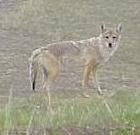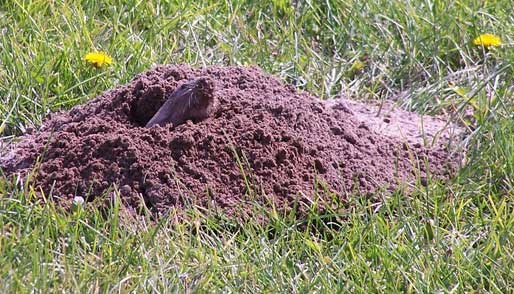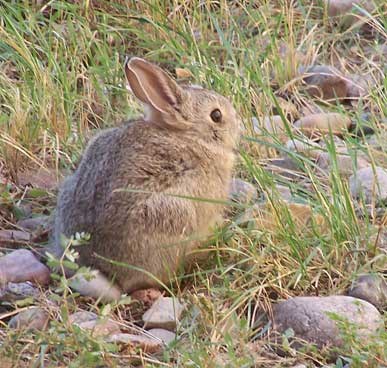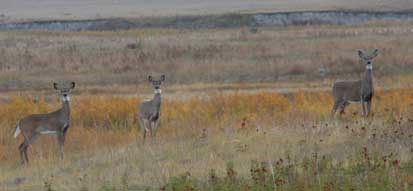
Predators are animals that actively hunt for smaller animals. The predators at Agate include coyotes, swift foxes, red foxes, long tailed weasels, mink and badgers. Most predators are nocturnal, meaning they are active by night and are usually seen at dusk or early morning. Most predators hunt for rodents and other small mammals, insects, amphibians and birds. Coyotes, red foxes and swift foxes belong to the family Canidae, which also includes domestic dogs and wolves. Coyotes prey upon small rodents, rabbits, and young or sick deer, sometimes hunting in small groups of two or three. It is not uncommon to sight one at dusk or very early in the morning crossing the prairie. Coyotes are dusty gray to light brown, weigh 20 to 50 pounds, run with their tails down and look very similar to a medium sized dog. The foxes are distinguished from coyotes by their smaller size, weighing 15 to 20 pounds, and their bushy tail. Red foxes tend to be red brown to a dull black with white in the tip of the tail and black paws while swift foxes have a pale buffy-yellow coat with black spots on either side of their snout and tip of tail. Red foxes maintain a mixed diet of small birds, rabbits, rodents, insects, berries and nuts. Swift foxes prefer a diet of small mammals but do feed on insects. Swift foxes are only rarely sighted in the park but are known to be in this area. Minks, badgers and the long-tailed weasel belong to the family Mustelidae. They are characterized by a nocturnal, solitary lifestyle of eating small rodents, rabbits and aquatic life. Badgers are the largest of this family found in the area, weighing up to 25 pounds. The powerful burrowers hunt rodents and rabbits by using their large claws to dig up dens. Badgers are identified by a shaggy gray to brown coat, short bushy tail, white stripe on their face and dark colored feet. With thick fur, a loose tough hide, and heavy neck muscles to protect it as it bites, claws, and exudes (not spraying) a skunk-like musk, badgers are a formidable fighter. The smallest predator of the area is the long-tailed weasel that hunts small rodents up to the size of a jack rabbit. The long tail weasel's body and head is 8" - 10" long, it has 4" - 6" tail, and it weighs around seven ounces. The home range of this weasel is about 30 - 40 acres and populations are rarely larger than 15 - 20 animals per square mile. The coat of the weasel is dark brown with a black tipped tail and whitish under body. Though rarely seen, weasels make their home at Agate Fossil Beds, nesting in abandoned burrows of other animals. Minks are larger than the weasel, weighing one to three pounds with a body length of 12" - 17". Minks are rich dark brown with a white chin and occasionally white spots on the belly. Minks are excellent swimmers and prefer to live along river banks hunting frogs, rodents, birds and eggs. Several species of bats make their home in the trees and rock cliffs of the park. Species may include the silver-haired bat, red bat, hoary bat, fringed myotis, and the long legged myotis. Bats are the only flying mammal, their hands being modified into a wing that extends from the forearm to the side of the body and the hind leg. Bats use a locating system known as echolocation. The bat emits a series of super-sonic sounds that bounce off objects giving the bat their location. This allows them to fly in complete darkness and still locate prey. All bats at Agate Fossil Beds are insectivorous, meaning they eat only insects, most preferring moths and beetles. Felines are carnivorous animals with retractable claws, short faces and rounded ears. Two feline species occur in the park, mountain lions and bobcats. Mountain lions, called cougars and pumas, pass through this area in search of new territory but do not stay long as there is not enough prey or protective cover for them. Bobcats are small, stealthy creatures, usually seen at night when they are hunting small mammals and birds. Their small body (weighing 15 - 35 pounds) is tawny colored (grayer in winter), with indistinct black spotting. They have a short, stubby tail with 2 - 3 black bars and black tip above and pale or white below. Their face has thin, black lines radiating onto a broad cheek ruff with slightly tufted ears. Bobcats make their home in rock crevices, hollowed logs and under fallen trees and could possible live on or near the park. While bobcats may wander 25 - 50 miles in search of food and shelter, they generally remain within two miles of their dens. Information Text and photo by Kimberly Howard, Biological Technician, Agate Fossil Beds National Monument, August 7, 2002. 
Rodents, rabbits and other small mammals are a vital source of food for predators, which include mammals as well as birds of prey such as hawks and bald eagles. Agate's common small rodents are the pocket gophers, kangaroo rats, pocket mice, ground squirrels, masked shrew and voles. Rodents are characterized by having two long, sharp incisors on their upper jaw and two on their lower with a significant space between incisors and grinding teeth located in the back of the jaw. At least 15 rodent species are known to be within the park, making up half of the mammal species. As there are few trees at Agate, most rodents live in the ground in burrows and feed upon insects, nuts, fruits, grasses, and occasionally meats. Some are active during the cooler hours of the day, while others prefer only to be out at night. The beaver spend their time hidden in the willows and shrubs of the riparian areas. In the winter, you may notice breathing holes in the ice on the river. This is a good indication that beaver are in the area. 
Similar to the rodents are the rabbits, which also possess large incisors on the upper jaw but have smaller less obvious lower incisors. Their ears are long and they have a short cottony tail. Visitors will most likely see a desert cottontail browsing or resting near the Visitor Center and Museum. The cottontails can be distinguished from the jack rabbits by their small bodies, weighing 1 - 2¾ pounds, and fluffy white tail. Jackrabbits have long ears and larger, slimmer bodies, and are rarely sighted. Another small mammal is the striped skunk, which is related to the weasel, mink, and badger but is considered a predator. Skunks are omnivorous, meaning they eat insects, plants and meats. They dine on insects, grubs, eggs and berries, and occasionally catch mice. Striped skunks are around the size of a house cat, black with white striped body and tail and spray a terrible odor if startled or scared. Though not related, the raccoon is similar in diet and behavior, but his body is larger, weighing 12 to 35 pounds, with a salt and pepper colored coat and a black and white ringed tail. Raccoons also have an omnivorous diet of fish, insects, berries and nuts. Both skunks and raccoons are nocturnal and solitary, spending their days in dens made of abandoned burrows, fallen trees, or rock clefts. 
Hoofed grazers walk on two-part hooves formed by the third and fourth toes. The most commonly sighted of these animals are the white-tail and mule deer but pronghorns are occasionally seen, usually farther away from the Visitor Center and Museum. White-tails are easily identified by their fluffy white tails that wave while they bounce away. White-tails stand 3' - 3½' tall and weigh between 150 and 400 pounds. White-tails can run up to 40 mph and jump an impressive 30 ft. horizontally and 8½ ft. vertically. With a home range rarely over a mile wide, the white-tails at Agate spend most of their days browsing the forbs and shrubs of the wetland areas while spending hot mid-day hours resting hidden in the cattails and willows. Mule deer can be distinguished by large, mule-like ears, stockier bodies and they do not flag with their tail, meaning they do not hold it up as they run as white-tail deer usually do. Mule deer do not continually reside in the park they wander onto neighboring fields and migrate to higher elevations during the hot summer months. Males of both species have antlers that are shed in January or February and re-grown through summer to be ready for the rut (breeding season) in November and December. |
Last updated: April 10, 2015
